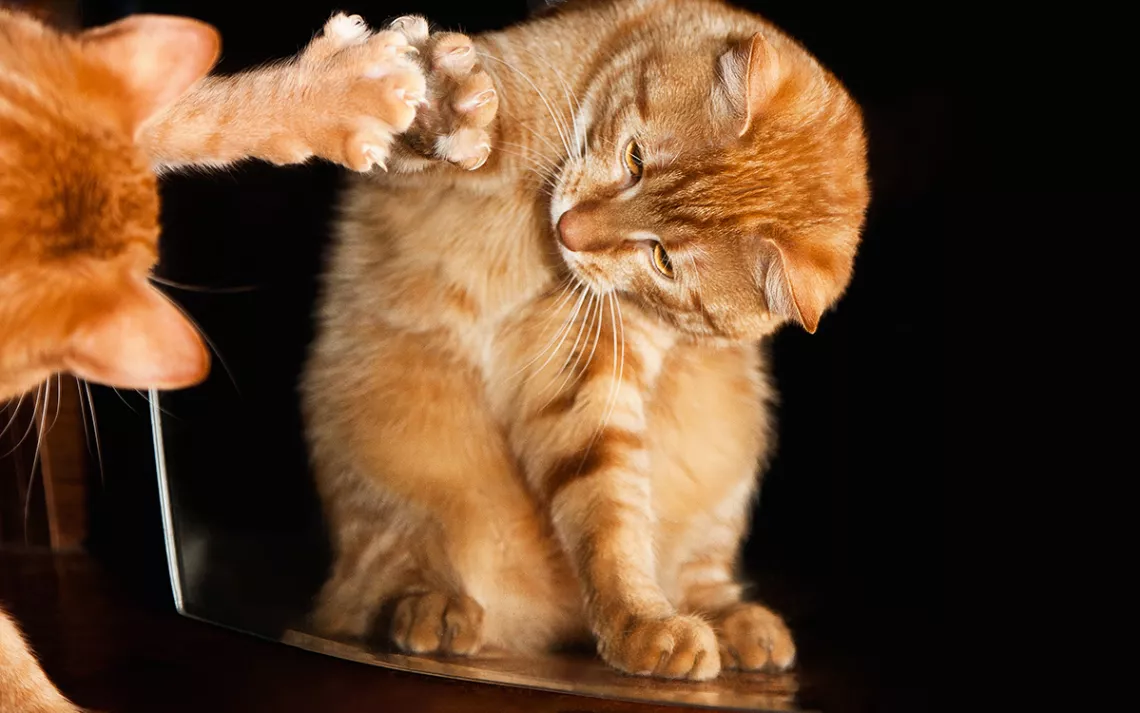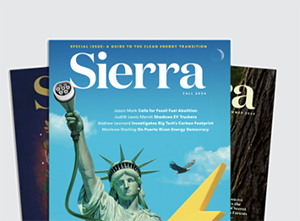The Science of Viral Cat Videos
How much can the mirror test tell us about animal cognition?

Photo by Valery Kurdyavatsev | iStock
In a recent video fad, users of Douyin, the Chinese version of the social media app TikTok, used a software filter to replace their on-screen face with a cat face and showed the results to their cats. Their pets’ eyes widened in shock as they tried to process the differences between their owners' real faces and the cat-faced on-screen versions.
These videos quickly joined a long-standing debate, on and off the internet, about what, exactly, is the deal with cats and mirrors. “For years, cats [were] trolling humans, making them think that they can't recognize themselves in a mirror,” Neo J. Ssk wrote in the comments of a video compilation posted to YouTube. “But here clearly you can tell cat knew exactly where to look as they saw the reflection of the app. They troll us for decades.”
It’s easy to see self-recognition in videos of other animals’ interactions with their reflections. When a cat is surprised by its own reflection, we laugh because the cat looks like it’s discovering it has ears for the first time.
When dolphins nod, open their mouths, and do backflips in front of a mirror, we assume that they’re checking themselves out.
Decades of scientific experiments into animal behavior have asked similar questions around animals and their reflections—when animals look in a mirror, do they know that their reflections are actually themselves?
The most well-known experiment designed to answer this question is the mirror test, developed by Gordon Gallup Jr. in the 1960s, when he was a graduate student in psychology at Washington State University. The idea came to him while he was shaving one morning, Gallup told me recently. Razor in hand, he found himself thinking about his ability to use his reflection to shave the stubble off his cheeks—then wondering whether animals would be able to do the same.
Now is the time for environmental journalism.
Sign up for your Sierra magazine subscription.

“Self-awareness is the ability to make yourself the center of your own attention. You can begin to think about yourself, not in terms of what’s happening to now, but also in relation to things that happen in the past and things that may happen in the future,” Gallup said. “What better way to confront self-awareness than to use a mirror?”
The experiment that Gallup developed would establish the standard for testing how other species perceived their reflections. A researcher put an animal in front of a mirror for several hours, taking notes on whether it seemed to recognize itself. Then, they anesthetized the animal and placed a mark—most often a red spot of dye—on a part of its body that it can’t see without the mirror—usually its face. Then the researcher placed the animal in front of the mirror again and took notes on how it reacted. Did it try to touch the mark or brush it away? If it did, it indicated that the animal understood that its reflection is itself, and therefore passed the mirror test.
Gallup’s mirror test provided an experimental framework for questions that psychologists and scientists had been asking for years about mirrors and the understanding of the self. In the 1930s, psychoanalyst Jacques Lacan proposed that once a child could recognize that its reflection is itself, it had acquired the ability to distinguish “self” from other.
“Once you become aware of your own existence, you’re in a unique position to make inferences about experiences in other individuals,” Gallup, now an emeritus psychology professor at the University of Albany, said. “And, I can use my knowledge of my own mental state like happiness and sadness and feelings of guilt and remorse . . . to make inferences about your ostensible mental state.” Animals that can pass the mirror test can do this, says Gallup.
To Gallup, even scientist-led experiments are not indicative of any deep truth about perception or about an animal’s “theory of mind,” unless the results of those experiments are reproducible across many repetitions and adhere to his specific set of indicators. Under those specifications, Gallup found that chimpanzees did pass the mirror test, but monkeys did not. Other researchers went on to use the test to pass more species, like bottlenose dolphins, killer whales, bonobo apes, orangutans, Asian elephants, magpies, pigeons, ants, and cleaner wrasse fish (but Gallup maintains that only humans, chimpanzees, and great apes pass the mirror mark test conclusively).
So those cats in the viral videos? Not passing the mirror test, according to Gallup. He holds that most animals—like cats—have “clever brains but blank minds.” They react to mirrors without realizing that the creature in the mirror is them and in turn, without realizing that they exist as an individual entity separate from others. For example, the cats in the cat-filter viral videos might be able to recognize their owner’s face on the phone screen but not recognize their own image as themselves.
This is similar to several of Gallup’s previous experiments with rhesus monkeys—he found that the monkeys could understand how mirrors worked and recognize other creatures and people in the mirror—and yet never seem to understand their own image as themselves. “We discovered that if we entered the room quietly, as soon as they saw us, they’d turn around,” Gallup recalled. “They recognized the dualism in the mirror, but they never came to grips with the dualism in the mirror as themselves."
Not everyone believes that the mirror test measures what Gallup intended it to. Daniel Povinelli, a professor of biology at the University of Louisiana who studies cognitive functions in great apes and humans, argues that chimpanzees might not be passing the mirror test at all, since what could be interpreted as self-awareness has too many alternate possibilities. Perhaps a chimpanzee perceives its reflection as another creature that it can control, or perhaps its movements are an attempt to alert its reflection to the existence of the mark.
It’s also possible that some animals that are failing the mirror test are doing so because they just aren’t very interested in mirrors. How do we know that a monkey would even care enough about a red mark on its face to inspect it—even if it did know its reflection was itself? Do cats and dogs lose interest in mirrors because they fail to perceive their own reflections, or because so much of how they interact with the world has to do with smells and a mirror doesn’t have any? (Some scientists have tried to develop olfactory mirror tests in an attempt to ameliorate this conundrum.)
And what about an animal like a manta ray—who performs "unusual or repetitive body movements” in front of a mirror” like circling in front of it and blowing bubbles but does not display actions that scientists define as “social”?
How would you test an octopus—whose understanding of the world depends so much on chemical receptors in its tentacles that form a kind of haptic taste? What does it mean when scientists can train rhesus monkeys to use mirrors and those monkeys then begin to innovate their own behaviors that pass the mirror test? And what does it mean that, in some cultures, children fail the mirror test until they are six or older? Other scientists have shown more flexibility in interpreting self-recognizing behaviors, or gone on to adopt theories like those proposed by Emory University biologist and primatologist Frans de Waal, which state that self-awareness is not binary but exists on a spectrum.
The mirror test and its interpretations have become their own kind of Rorschach inkblot tests, revealing as much about us as it does the animals we seek to understand. “We do not know precisely what these animals know about themselves,” wrote ethologist Mark Beckoff about the mirror test and animal self-recognition. “We must be careful neither to imbue animals with unknown cognitive capacities nor to rob them of skills that they might possess.”
 The Magazine of The Sierra Club
The Magazine of The Sierra Club



